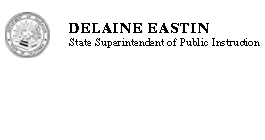GASB 34 New Financial Reporting Requirements


Official Letter
Official Letter
November 15, 1999
To: County and District Superintendents
County and District Chief Business Officials
From: Janet Sterling, Director
School Fiscal Services Division
Subject: New Financial Reporting Requirements
In June 1999, the Governmental Accounting Standards Board (GASB) issued Statement 34, Basic Financial Statements-and Management's Discussion and Analysis and Analysis-For State and Local Governments. This new standard will significantly change the way school districts and county offices of education report their finances to the public. Shifting the focus of financial reporting from the status of individual funds to the overall status of the local educational agency's (LEA) financial health, the new standard requires that more and easier to understand financial information be presented to the public.
The requirements of GASB Statement 34 are phased in based on the LEA's total annual revenues. The following table displays the three phases.
| Phase | Total Annual Revenues | Effective Beginning With |
|---|---|---|
1 |
$100 million or more | Fiscal year 2001–02 |
2 |
At least $10 million but less than $100 million |
Fiscal year 2002–03 |
3 |
Less than $10 million |
Fiscal year 2003–04 |
Overview of GASB Statement 34
The new financial reporting model under GASB Statement 34 requires the following additional information for the annual financial reports of school districts and county offices of education to be presented in conformity with generally accepted accounting principles (GAAP):
- Management's Discussion and Analysis
- Basic Financial Statements
- Required Supplementary Information
Management's Discussion and Analysis.
This narrative should introduce the financial statements and provide an analytical overview of the LEA's financial performance for the year. Financial managers of LEAs should include sufficient information in the analysis for users of the financial statements to evaluate whether the financial position of the LEA has improved or deteriorated as a result of the year’s activities.
Basic Financial Statements. These statements consist of fund-based financial statements, government-wide financial statements, and notes to the financial statements.
- Fund-based Statements. While there are some changes being made to the existing fund-based statements, most of the requirements remain the same. The primary change to these statements is a new summary reconciliation to the government-wide financial statements that will be presented at the bottom of the fund financial statements or in a separate schedule. (See Attachment A for an example of the reconciliation.)
The existing fund-based statements use a current financial resources focus, which means that they measure whether events or transactions have changed the available resources in the short-term. The governmental funds will continue to be reported using the modified accrual basis of accounting, and will have a balance sheet and a statement of revenues, expenditures, and changes in fund balance.
The modified accrual basis of accounting recognizes revenues in the period in which they become available and measurable, and recognizes expenditures generally when the fund liability is incurred, except for certain liabilities such as debt services (when due), and compensated absences to the extent they affect current outflow.
- Government-wide Statements. The government-wide financial statements are being added to provide additional financial information from an overall perspective. In contrast to the fund-based statements which look only at the short term, these statements will look at the whole picture, both short and long-term, will use the full accrual basis of accounting, and will consolidate all the funds into one statement.
The full accrual basis of accounting recognizes revenues in the period in which they are earned and become measurable, and recognizes expenses when they are incurred.
The government-wide statements will consist of a statement of net assets and a statement of activities. The government-wide statements will report all of the assets, liabilities, revenues and expenses (including depreciation) of the LEA. Capital assets such as land, buildings and equipment will be included in the statement of net assets; liabilities will include any general obligation debt and other long-term debt. (See Attachment B for an example of a government-wide financial statement.)
- Notes to the Financial Statements. In addition to the current note disclosures, information about the government-wide financial statements will be included.
Required Supplemental Information.
LEAs will need to include a schedule that not only compares the final budget with actual information but also compares the original budget with actual information for the general fund and special revenue funds.
Implications for LEAs
GASB Statement 34 has vast implications for LEAs, including the addition of government-wide full accrual reporting and new budgetary comparisons. We will be further reviewing and analyzing GASB Statement 34 to determine the changes that must be made to our financial reporting software, such as creating new account codes and schedules to convert fund-based information to government-wide information.
Full Accrual. When preparing the government-wide statements, it will be necessary for LEAs to convert their financial activities from the modified accrual to the full accrual basis of accounting. While not all-inclusive, following are what we believe to be the resulting changes:
- Assets. Currently, most LEAs do not report their general fixed assets account group. However, capital (fixed) assets will be included in the statement of net assets as part of the government-wide financial statements. If capital assets are not included on the statement, the total net assets amount, i.e., the bottom line, will be understated. If the LEA has significant long-term liabilities but no capital assets reported, the net asset amount could be negative. LEAs should begin planning to have their fixed assets valued so that the information is available for inclusion in the statement of net assets. Once GASB 34 is implemented, LEAs should also begin calculating annual depreciation of these assets.
- Liabilities. The long-term liabilities of LEAs are currently presented in the general long-term debt account group at the far right of the balance sheet statement. By including the long-term liabilities in the statement of net assets, the LEA's long-term liabilities will be more prominently displayed and, of course, will reduce the total net assets amount. This means that readers and users of the financial reports will be more fully informed about the impact of the long-term liabilities on the LEA's financial position. For example, the costs of providing certain employee benefits, such as post retirement benefits, will be prominently displayed and will clearly have an impact on the LEA's net asset amount.
Budget comparison. Financial reports currently include a comparison of the final budget to actual revenues and expenditures, which shows whether resources were obtained and used in accordance with the LEA's legally adopted budget. The additional inclusion of the original budget in this comparison will now also illustrate the magnitude of the budgetary changes made throughout the year. If the changes are significant, the reasons for them must be included in the Management’s Discussion and Analysis.
There are likely many other implications for LEAs that we have not yet identified. The ones that are mentioned in this letter should be a start for LEAs to consider how GASB Statement 34 will affect them. We will continue to notify you of the GASB Statement 34 implementation issues as they are identified. For more comprehensive information, we recommend that you review GASB Statement 34, which may be obtained directly from GASB. Both the GASB phone number and addresses may be obtained from the GASB Website at https://www.gasb.org/. If you have questions regarding this letter, or if we can be of further assistance, please contact the Office of Financial Accountability and Information Services at 916-322-1770 or send an email message to sacsinfo@cde.ca.gov.
Please note that this letter is available on the California Department of Education Website at the following location: http://www.cde.ca.gov/fg/ac/as/correspondence.asp.
